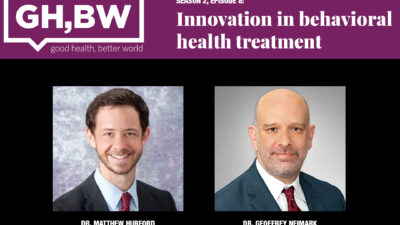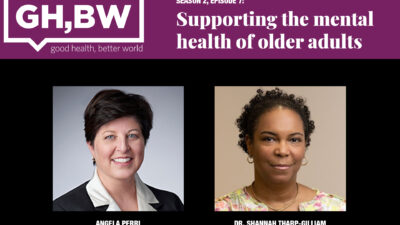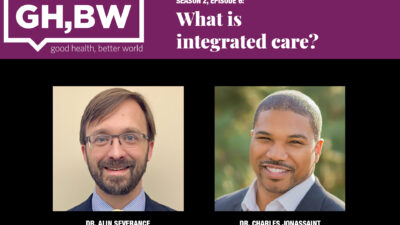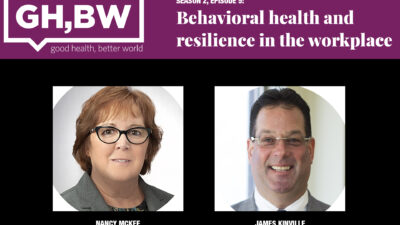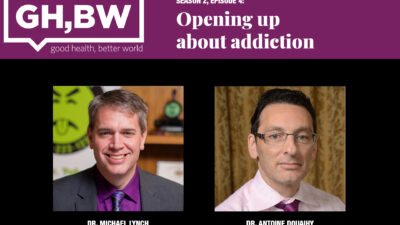In this episode:
What’s the new frontier in behavioral health? That great frontier might not always mean being in a doctor’s office. Learn more about how telehealth, new therapies, and whole person care — where you live and play — affect well-being.
Hear from Dr. Matthew Hurford and Dr. Geoffrey Neimark of Community Care Behavioral Health, a not-for-profit behavioral health managed care organization. Says Dr. Hurford, president and CEO: “We cannot get to whole person care without thinking about whole community care.”
Have questions? Email us at [email protected]
Resources:
Are you experiencing a crisis or are concerned about a loved one?
- For general help, Allegheny County residents can call resolve Crisis Network which provides crisis counseling for a variety of issues, at 1-888-796-8226, or click here.
- For help with addiction, call the Substance Abuse and Mental Health Service Administration’s hotline at 1-800-662-4357, or click here.
- For general resources on addiction and mental illness, visit the Substance Abuse and Mental Health Services Administration, here.
- For help with a mental health crisis, reach the National Alliance on Mental Illness by dialing 988, or click here.
- To reach UPMC Western Psychiatric Hospital and UPMC Western Behavioral Health, call 1-877-624-4100, or click here.
- UPMC Health Plan members can learn more about behavioral health programs, tools, and resources, by clicking here.
- To learn more about Community Care Behavioral Health, click here.
More:
Psilocybin, the psychedelic chemical found in so-called magic mushrooms, may help treat depression in some patients, according to a new study in the New England Journal of Medicine, as reported by CBS News.
Dr. Jack Resneck Jr., president of the American Medical Association, writes that despite an investment of dollars by the federal government, there’s a crisis in the treatment of mental and emotional health that calls for more professionals, and new approaches. Read the column, here.
Findings from a University of Pennsylvania study, suggest that improvements — such as those related to safety — in an individual’s environment can have a positive impact on their emotional health.
The American Hospital Association lists innovation in behavioral health treatment resources that include how the integration of physical and behavioral health improves patient outcomes and satisfaction.
Scientific American takes a look at methods and technologies that are transforming the work of psychiatrists and psychologists in the special report The Top 10 Innovations in Mental Health.

Dr. Ellen Beckjord: On this episode of Good Health, Better World, we're going to discuss innovations in behavioral health treatment. And I'm very excited to welcome two guests, Dr. Matthew Hurford, president of Community Care Behavioral Health Organization and vice president of Behavioral Health at UPMC Health Plan. And he's joined by Dr. Geoff Neimark, chief medical officer of Community Care. Welcome to Good Health, Better World.
Dr. Geoffrey Neimark: Thanks. Excited to be here.
Dr. Matthew Hurford: Thanks, Ellen. Good to be with you.
Dr. Ellen Beckjord: So, as we think about innovations and behavioral health treatment, there are any number of places we could start, from technology like virtual group offerings to breakthroughs in genetic research. There are so many exciting advances in behavioral health, diagnosis and treatments.
Dr. Hurford, if I can start with you, what are some of the latest innovations in behavioral health when it comes to technology specifically?
Dr. Matthew Hurford: Well, Ellen, I think when we talk about the latest innovations, particularly around technology, the first one that probably comes to most people's minds comes from the experience that we all went through as a result of COVID. And that is the ability to access care through virtual and remote platforms, whether that means using a phone, a smartphone, your computer, texting, or any number of digital platforms or applications. Because we had to pivot so quickly as a society to a lockdown, and using social distancing, we were deprived of many of the usual pathways for us to access care, and behavioral health was no exception. And, in fact, we saw a greater movement towards virtual and teledelivery options in behavioral health, and really in any other segment of health care. And that, for us, meant an opportunity to assess, address, and ultimately evaluate our ability to close gaps in care, which is so fundamentally important.
Dr. Ellen Beckjord: I’d like to ask about whether and how you think that virtual care delivery or care delivered not face-to-face, but perhaps over video, or as you said, even asynchronously over text…has that changed what a visit looks like, or in some cases what delivery of behavioral health treatment looks like? And if it's challenged previous models, you know, are there pros and cons to that? But how has it really changed what a visit or treatment might look like?
Dr. Matthew Hurford: It's a great question. I think it absolutely has changed and I think it's called into question, what do we think of as a kind of unit of health care?
I think, historically, we thought whether for behavioral health or primary care, or any of the medical subspecialties, we've thought about a pretty classic engagement strategy where we think about an office visit and when we say that it probably conjures up this similar idea in most people's minds — you make an appointment, you go to an office, perhaps you meet a receptionist, you sit in a waiting room, maybe read a magazine for five, ten, 15 minutes, get seen by a nurse, talk to your doctor or your therapist, and then you leave.
And that sort of discreet visit is how we, most of us, consume health care. Well, the world changed in 2020, as we know, and suddenly it's almost as though we jumped into a time machine and there was a huge pull forward in lots of technologies that were just beginning to emerge and come onto the scene that suddenly got fast-tracked with tons of investment in the kinds of digital and remote and virtual offerings that you were describing.
And, suddenly, not only were people connecting from great distances geographically, they were doing it, suddenly, in two dimensions instead of three. As we started to talk with our doctors, our nurses, our therapists on a screen instead of in-person.
We were also doing it asynchronously. So suddenly, much more use of email, texting and other digital platforms to communicate with our care providers and our care teams.
And so this idea of an office visit or doctor's visit or therapist visit is giving way to a new idea around an engagement.
And I think going forward, we're going to see much more of that kind of redefinition of what it means to engage in care around a longitudinal experience, some of which takes place in real time, some of which takes place asynchronously through messaging and other digital platforms. And some of it, of course, continues to take place in person, when that makes sense.
Dr. Ellen Beckjord: All of that is making me think about the accompanying work that seems like — I'm sure it's happening but will be necessary — around how payment for care delivery needs to accommodate and adjust as the model shifts, and also how core constructs in behavioral health treatment like therapeutic alliance might be affected, or even boundaries around relationships between providers and clients or patients.
Because all of those things come into play and get affected by the fundamental changes in the model of care delivery, which, of course, has lots of advantages, as you've noted, with respect to access and, possibly, even impact. But it seems like there's probably a lot that we have yet to really study closely and fully understand.
Dr. Matthew Hurford: Great point. And I think it's important to recognize that we have gone through technological changes in health care before, and the same is true in mental health treatment.
In the early days of psychoanalysis, didn't have to worry about phone calls. And yet, as that technology came onboard, that was part of something that had to get incorporated into the therapeutic frame, something that therapists and patients needed to sort of consider. And the same is true and going to be true with new technologies like texting, email, and virtual.
Dr. Ellen Beckjord: Dr. Neimark, I'd like to ask you about some ideas related to what happens in that treatment encounter — sort of building on the ways that treatment gets delivered has changed, but if we think about models of care and types of behavioral health treatments, what newer therapeutic models are available? Where have you seen, or what might you be most excited about with respect to advancement or innovation in the kinds of treatment available, and for which types of mental health challenges or disorders?
Dr. Geoffrey Neimark: So, it's an excellent question. And, I think, there have been a number of advances in behavioral health treatment available to patients, and I'll talk about a few of them with a focus on medications, somatic treatments, and some of the psychotherapy areas.
In terms of medication, there have been developments of a number of psychotropic medications that really work through novel or new mechanisms.
And these are really drugs that exert their effect through different pathways than our existing medication options, beyond what is often referred to as “me-too” medications, things like Zoloft, Prozac, or Paxil, all of which are serotonergic antidepressants, but not tremendously different from each other.
And these newer, distinctive medications really offer possibilities in terms of treatment outcomes, like efficacy, speed of onset, which can be really important in certain cohorts, and importantly, fewer side effects. So, I'll just call out two of them.
One example is a newer medication called allopregnanolone, which is actually a naturally occurring neuro steroid, which is now available via intravenous infusion for the treatment of moderate to severe postpartum depression. It can produce its clinical effect within hours or days. And you can imagine that's really critically important for new mothers and their children.
Another example is esketamine, which is a variant of ketamine, a drug you may be familiar with from anesthesia or from the popular press. It really functions as a glutamatergic antagonist, and it's currently available for administration through nasal inhalation, and it's now indicated for treatment-resistant depression and acute suicidality.
So again, specific cohorts for treatment-resistant depression and also speed of onset.
Beyond these novel medications, we've also seen advances in the field of pharmacogenomics. These are really allowing us to better predict how patients will respond to medications. So, we now have the ability to really take a sample of, and analyze a patient's DNA, and that really allows prescribers to get a sense of how patients are going to respond to this medication.
For example, you can see if someone's missing an enzyme that breaks down this medication and they'd be considered a poor metabolizer, and that would lend to high levels of accumulation of the medication, which really can produce often toxic side effects or problematic side effects. So, you know, if you were the doctor and you saw that, you wouldn't prescribe that medication.
There are new possibilities, both in the sorts of medications that are available that really allow us to enhance efficacy, speed of onset, fewer side effects, and this enhanced ability to assess an individual's clinical response, so we can better tailor pharmacological treatment for patients.
In addition to the medications, there have been advances in what's often referred to as “interventional psychiatry,” or the use of medical devices in the treatment of psychiatric disorders.
So, for many years, ECT or electroconvulsive therapy was really the only available option, and it comes with some side effects. But in the past decade or so, there's really been significant advances in this area, particularly around transcranial magnetic stimulation, or TMS, where the use of this non-invasive magnetic field that's really administered through pulses and a wand in an office setting, has really been shown to be quite effective in the treatment of depression and, more recently, anxiety disorders, and, so, I anticipate that TMS use is only going to continue to grow and really has produced impressive results with much fewer side effects to date.
I also want to draw attention to the fact that novel technology is helping to shape some of our treatment options. There's an entire class of electronic treatments known as prescription digital therapeutics, and these are approved by the FDA for disorders ranging from opioid use disorder to ADHD to insomnia. And they really have quite remarkable demonstrated efficacy and may really be game changers when it comes to thinking about how we engage patients and how we think about access.
You know, certain folks might not otherwise really think about treatment, but if there's an app available for them that they can jump into on their cell phone, they might be willing to do that.
Interestingly, I've talked a lot about medications and lab tests and devices and apps, but not as much about therapy. And one therapy I just want to specifically mention that I'm excited about is contingency management.
It's not necessarily a new therapy, but it's really a potent tool in the treatment of substance use disorders, particularly for those that don't have medications approved for them, things like methamphetamines or cocaine. And really, it's, what it is, it's a modification of behaviorism. It's premised on something called “operant conditioning,” which sounds complicated, but at its core, it really variably rewards desired outcomes. So, what that means is, if you have a problem with a substance and you're able to not use it for a certain amount of time, you can get a cash prize or a gift card, something that really is rewarding and that helps promote further non-use of substances. But contingency management is an evidence-based modality — it has a ton of evidence, and I'm optimistic that with some of the regulatory barriers that have really prevented its widespread use related to its payment, it's going to increasingly be available moving forward.
Dr. Ellen Beckjord: Can I ask you a follow-up question about contingency management as it relates to digital tools in particular? And I don't think you knew this before you brought this up, but I'm like the president of the B.F. Skinner Fan Club International. Really.
Dr. Geoffrey Neimark: So, I did not. That's news to me.
Dr. Ellen Beckjord: My question, Dr. Neimark, is, do you think that the emergence of contingency management — I'm saying that correctly, right? — which is not a new idea, correct? But is it having its sort of day in the sun, or positioned to reach a new level of potential, because of the availability of real-time technology to either sense the behavior occurring or not occurring and alert the person receiving that modality of the reward? I think time is just so important, when it comes to reinforcement and without real-time notification, it seems like the potency of that modality would be way lower.
So, do you think that the availability of contingency management as a good therapeutic modality, particularly in the realm of some addictions, is really powered by the co-occurrence of the availability of technology?
Dr. Geoffrey Neimark: I think that the availability of technology will serve to augment its adoption.
There are some existing apps — when we talked about digital prescription therapeutics — that actually are using contingency management currently for the treatment of substance use disorders. But to your point, they're not doing it in as proximal a timeframe as might be optimal to get the desired award. They still are working on a bit of a delay. So, I think the time is right.
Dr. Ellen Beckjord: Well, that's all very exciting. Switching gears a little bit — or maybe not switching gears so much as taking a broader view or going up a level — so, Dr. Hurford it’s exciting to hear about innovations in care delivery, innovations in access, but if we think at a foundational level, how important are community connection and social engagement to behavioral health?
How do we think about some foundational constructs related to social connection, community connection, as being really important to improving and helping people maintain good behavioral and mental health, alongside access to treatment that’s very important for lots of people?
Dr. Matthew Hurford: Well, it turns out to be incredibly relevant and very important, not just to behavioral health, but total health. And we had this global and tragic experiment that illustrated that when suddenly, in a matter of days, so many people around the world were deprived of that daily social connections and opportunities for community engagement that they enjoyed in their day-to-day lives — going to work, meeting with friends and family, going to places of worship together — things that we sometimes, in behavioral health, refer to as “natural supports,” things that have been considered outside of the treatment system, or don't always find their way onto a treatment plan.
When we turn and look at behavioral health specifically, loneliness has been clearly associated with higher rates of clinically significant depression, anxiety and suicidal ideation. So, what can be done about it? And here's where I think we have another really exciting frontier of innovation, that in some ways represents a kind of return to our roots and a return to our common sense.
When you think about it, it makes all of the sense in the world that having strong relationships, feeling connected to people, places and opportunities that are meaningful, are going to help our overall psychological and emotional health. And, so, there are innovations and interventions that specifically help people experiencing behavioral health challenges, to participate meaningfully in their communities of choice, and really develop and foster relationships and engagement in activities that we know are associated with better health, and, so, many of these don't even require the kinds of technological innovations that we've discussed, although I think there's some exciting opportunities to augment them, as Dr. Neimark mentioned.
But therapeutic models and delivery and disciplines, such as psychiatric rehabilitation, which is a discipline where individuals are specifically trained to help people who are experiencing social emotional disturbances or have a psychiatric disability, to really navigate their way through the community.
So, for example, a psych rehab specialist may work with somebody who experiences major depression or schizophrenia to be able to volunteer at a local organization or apply for a job or overcome some social anxiety and begin attending a church service that they haven't been to, because of their social anxiety. So it's very pragmatic. It's focused on the kinds of activities that we all derive meaning from, but may be unavailable to people because of their symptoms, or because of their behavioral health challenges.
In a similar way, peer support is an exciting platform and discipline. Peer support involves people who have lived experience with mental health challenges or, in the case of certified recovery specialists, substance use disorders. And these are individuals who have gone through and are in recovery from a mental health or substance use challenge, and they've been specially trained to work with people who have similar challenges, engage them, empathize with what they might be going through, draw upon their own lived experience to make empathic connections and help them to be able to identify what their individual goals are and what their barriers to achieving those goals might be and helping them to navigate the system, not in lieu of what we think of as formal treatment, but in addition to.
I would say that this couldn't come soon enough, because we also know, from research, what we do and in kind of the formal treatment system — so, think: office visits, surgical procedures, medicine, rehabilitation — all of the things we would define as traditional health care — at most only account for 10 to 15% of people's whole health outcome.
The other 85-90% is a mixture of things that oftentimes are outside, or have historically been outside of the purview of health care, things like your genetic makeup, your zip code, where you live, your behaviors in day-to-day.
And, so, the take home point here is, that even if we optimize for everything on that formal or legacy treatment side of the system, we're still not treating the whole person, and so we need to continue to innovate and find ways to help people have meaningful connections, address social isolation and loneliness, and help maximize their chance for a full, meaningful life in the community.
Dr. Ellen Beckjord: So, another way — tell me if you think this is fair to think about or talk about — what you just said with respect to psychiatric rehabilitation, peer support — is context, which is second on my list of obsessions, right behind B.F. Skinner.
I find context to be so fascinating and so determinant of behavior, determinant of lots of things. But one of the ways that I think we can think about all the things you just said is that those levels of intervention, whether it's the psychiatric rehabilitation model or peer support, how do we change the context in which people are experiencing their life? How can we think about ways to change or influence context to drive changes in experience that are aligned with recovery, with better mental health and well-being, with improved mood, and the like?
And I think of context as being sort of multilevel, you're talking about sort of environmental context, but there's also, I think, internal context, which can be affected by pharmacological intervention — and that's a segue into a question that I wanted to ask Dr. Neimark, but happy to hear your thoughts about it, too, of course,Dr. Hurford, which are other new medicines, psychedelic medicines in particular, and psychedelic-assisted psychotherapy, that are getting a lot of attention right now. You mentioned esketamine, which I would consider in this category. I know other substances, other psychedelic medicines that are currently being studied and in varying levels of FDA approval, would be MDMA and psilocybin, which I believe all have very different mechanisms of action. You had talked about that earlier, and all significantly change internal context temporarily, the way the mind functions, which then affects the way people experience the world. And there's been lots of really promising research for how that temporary change in internal context has been associated with gains in recovery, from treatment-resistant depression, from long-standing post-traumatic stress. But these are new substances, they're controlled substances.
So, there's lots of things to consider, but I'm curious about your take on some of the things you might feel hopeful about with respect to psychedelic medicine, some of the things you think we need to be cautious about, and whether and how some of the ways these medicines are helping to overcome some barriers to recovery in certain disorders, are or might be achieved even through other mechanisms, like some of the ones that Dr. Hurford just described, that are very kind of back-to-basics, human-to-human connection.
Dr. Geoffrey Neimark: I think a starting point is really to probably consider the long and fascinating history of psychedelics. I mean, they've been around and used by indigenous societies for thousands of years, but they are widespread in non-indigenous societies.
So, in particular, I think we've seen that psilocybin has demonstrated efficacy around depression and MDMA really in PTSD. And I'd say some of the results are quite impressive, showing higher response rates and remission rates for psilocybin in the treatment of depression than with conventional treatments. Similarly, there have been some profound improvements in PTSD, where there was one study that was published in the Journal of the American Medical Association that showed 70% of individuals who had a PTSD diagnosis achieved remission after using the agent — far superior to what we see with, you know, the existing treatments. It's worth noting also that there have been some pretty remarkable, though small, outcomes in the areas of substance use disorder.
Now, I do want to say that not all results have been positive — and fair to say probably larger studies are necessary — but it's very promising and, I think, also quite accurate to say that psychedelics not only provide hope, but increasingly meaningful and quantifiable results, particularly for certain cohorts of patients. And, I think, getting into the second part of your later question was the area of treatment-resistant conditions.
I'll also, you know, point out that they're remarkably safe from a physiological perspective. Their biggest risk is psychological, and that really can be mitigated. So, all in all, I think they offer much promise and I'm really very excited about their expanded use.
Dr. Matthew Hurford: Can I build off this point? Because I think Dr. Neimark really highlights a lot of the very encouraging evidence to support the potential applications of these new, old compounds that were rediscovering their potential utility. But one of the barriers that we're going to have is some of the stigma associated with how most people associate — things like psilocybin, oh, that's shrooms; or MDMA, oh, that's ecstasy, that's a club drug or a party drug — and it strikes me that it's incumbent upon us as a scientific community, as well as a healing community, to look at these in a very dispassionate, scientifically rigorous and objective way. The evidence is very promising and building.
Dr. Ellen Beckjord: I want to go back, actually, to the question about access, because — and this is really a question for either or both of you — within the realm of behavioral health, psychology and psychiatry, we have a lot of treatments that have a lot of evidence that support their impact, and if more people had the opportunity to access those treatments independent of a potential accelerator through the addition of some kind of pharmacotherapy, you know, are we, is part of what we need to innovate around simply the idea of getting more people access to treatments that we know work?
Dr. Matthew Hurford: Right. So, if this is a full disclosure session, then I've got to share that I'm a card-carrying charter member of the Evidence-Based Practice Implementation Society. It's a small society, but we're looking for members.
Dr. Ellen Beckjord: I’d like to join.
Dr. Matthew Hurford: Your point about the opportunity to close the gap between the needs we have within health care and the availability of evidence-based practices to meet those needs, to me, is one of the great unmet needs in our society, not just in health care. This has been well-studied. And the evidence shows that it takes anywhere from eight to 18 years from the time when a treatment is established through the gold standard.
That means that, right now, there are people that are suffering and dying from physical health and behavioral health challenges for which there are evidence-based treatments that they are not able to access. And it might be for a variety of reasons.
Closing that eight- to 18-year gap and getting those treatments to the people that need them in a more timely way, is one of our greatest opportunities, because we don't have to invent anything. All we're trying to do is Uber-ize or Amazon Prime health care needs.
Dr. Ellen Beckjord: When we think about disruption in care delivery and disrupting the whole system to overcome some of these longstanding and pretty entrenched challenges around the time that it takes from discovery to implementation, I think about policy as an enabler of that disruption, and I think about policy as a real leverage point in driving transformational change.
So, I wanted to ask about what you both see as promising advances at the policy level directly, or even indirectly, related to behavioral health that you think really will support the improvements that we need to see in access to and receipt of evidence-based behavioral health care and to improve equity in behavioral health, as well.
Dr. Geoffrey Neimark: So, I want to start with a bit of a focus on disrupting the system, because I think that really is necessary, and I think policy is going to follow that.
And one of the areas that I think has been most profoundly impactful on me has come about from reading the work of a number of researchers out of the University of Pennsylvania who have, I think, challenged us to reconceptualize the focus of treatment. You brought this up before, in essence, saying, you know, you're in a room with someone for 50 minutes and then there's a whole world system that concentrically goes out and impacts this person.
And how do we create interventions and opportunities to impact not only individuals, but communities? And, so, what these researchers at Penn have really done is challenge us to say, let's not look at the individual, let's look at the community. And, so what they did actually was quite innovative. They looked at what would be the outcome on mental health measures, particularly areas like distress and depression, if we were to clean up people's neighborhoods by putting some more green spaces in them and removing the trash, and they conducted a nice randomized study and saw, lo and behold, that if you help someone's environment, if you make it nicer, that there are meaningful results that you see in their mental health.
Similarly, and I think this is very timely, they've done some significant work about violence and crime in the City of Philadelphia and have published around the fact that blight remediation — so, really fixing up houses, cleaning up trash — has tremendous impact on crime rates, on violence in communities.
So, I think this is really a sort of emerging area of importance. It's a body of research that is, I think, pushing us to focus on communities, as opposed to individuals, and around population-level outcomes.
And I think, Dr. Hurford will probably talk about this a little more, but it shifts the way we think about sort of our traditional one-on-one or dyadic or limited-system intervention. This is really taking it to the next level, but it's not the way we've traditionally approached or thought about mental health.
Dr. Matthew Hurford: I think those are great examples that are helping us to stretch the boundaries of our concept of where our therapeutic opportunities exist.
So, while it is critically important that we have equity within hospitals, clinics and other care facilities, we are beginning to see and be able to measure the value of engaging natural supports, community resources, and other opportunities outside of those traditional therapeutic environments. And so, policies that, at first glance, may not be associated with behavioral health and wellness, are gaining traction and attention.
One example would be, policies related to parental leave. There was a study in the American Journal of Preventive Medicine in 2021 that demonstrated that exposure to paid family leave policies was associated with decreased psychological distress among parents. And again, that may make total sense, but this study was really able to quantify the meaningful impact. So, something that may have historically been thought of as a workforce policy, we can now broaden our definition and think of it as a health care intervention and specifically around a mental health initiative.
I think the other area related to policy that is really opening up new frontiers, relates to the expanded flexibility in public funding sources like Medicaid and Medicare, but certainly within commercial insurance and other insurance funding streams to support and reinforce the social determinants of health, or social influencers of health that we know are so influential and so powerful in driving and determining somebody's total health outcome.
Now we have this opportunity around integrated care, a 2.0, where we're discovering the sidewalk. We're discovering the stoop. We're recognizing that people live and thrive in their entire community, not just in their 15-minute therapy session.
And the more we are able to embrace that understanding, engage and mobilize all of those facets in someone's life, the more opportunities we have to help support them leading those full, healthy, meaningful lives in the community.
Simply put, we cannot get to whole person care without thinking about whole community care.
Dr. Ellen Beckjord: Absolutely. When I think about sidewalks, for example, both are implicated. If you can't go out and walk safely in your neighborhood, it's not good for your physical health. But all of those social health indicators and then how we intervene at a community level to promote social health through everything from what you've just talked about at that policy level, we can really intervene to improve access to the benefits that our social environments have to offer us, when those benefits are there and can bring more of those benefits to bear, to really get to that whole person and whole community health vision, which is incredibly important, and there's lots to be excited about with respect to innovation, in treatment and in policy, and I think that's a great place to end the conversation.
I want to thank both of you so much for being guests on Good Health, Better World. It was just wonderful to talk with you and really appreciate all of your insights and the information that I think gives us a lot to feel very hopeful about and very realistically hopeful.
Dr. Geoffrey Neimark: Thank you.
Dr. Matthew Hurford: Thanks for having us.

